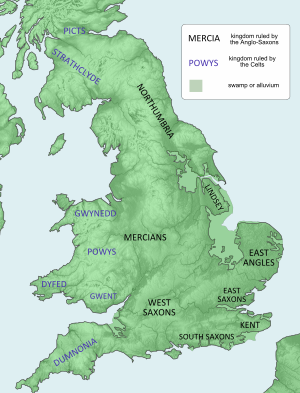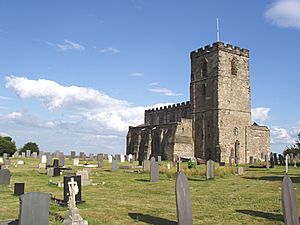Eardwulf of Northumbria facts for kids
Quick facts for kids Eardwulf |
|
|---|---|
| King of Northumbria | |
| 1st Reign | 14 May 796 – 806 |
| Coronation | 26 May 796 |
| Predecessor | Osbald |
| Successor | Ælfwald II |
| 2nd Reign | 808 |
| Predecessor | Ælfwald II |
| Successor | Eanred |
| Died | after 808 |
| Burial | Breedon on the Hill? |
| Issue | Eanred |
| Father | Eardwulf |
Eardwulf was a powerful ruler who served as king of Northumbria from 796 to 806. He was removed from power and went into exile, but he might have ruled again from 808 until around 811 or even 830. Northumbria, a kingdom in what is now northern England, faced many challenges in the late 700s. Different noble families were constantly fighting for control of the throne.
In 790, King Æthelred I tried to have Eardwulf killed. Eardwulf survived, which some people saw as a sign that he was favored by a higher power. In April 796, a group of nobles planned to kill King Æthelred. After Æthelred's death, Osbald became king, but his rule lasted only 27 days. Eardwulf then became king on May 14, 796.
We don't know much about Eardwulf's family, but his father was also named Eardwulf and was a nobleman. Eardwulf was married when he became king, but his wife's name is not known. Some historians think he might have later married a daughter of Charlemagne, a very famous emperor. In 798, Eardwulf fought a battle against a nobleman named Wada, who had been involved in killing King Æthelred. Wada was defeated and forced to leave the kingdom. In 801, Eardwulf led his army against Coenwulf, the king of Mercia, possibly because Coenwulf was helping others who wanted to be king of Northumbria.
Eardwulf was removed from power in 806. A record from the Franks (people from what is now France and Germany) says he returned to his kingdom in 808. We don't have any records about when he died or when his second reign ended. Some historians suggest he died between 811 and 830. He might have been buried at the Mercian royal monastery of Breedon on the Hill, which is dedicated to Saint Mary and Saint Hardulph. Some historians believe Saint Hardulph is actually Eardwulf.
Contents
Northumbria's Royal Struggles
During the late 700s, Northumbria had many kings who were either killed or removed from power. Several royal families were always fighting to control the throne. The main families were those of Eadberht, Æthelwald Moll, and Alhred. In the eight years before Eardwulf became king, all three of these families were involved in the struggle for power.
For example, in 788, King Ælfwald I was murdered. His cousin Osred then became king, but he was removed after just one year. Then, Æthelred, who had been king before, returned to power. This shows how unstable the kingdom was.
Kings in this period didn't rule alone. They governed with the help of important church leaders and nobles. These nobles were often called dux (meaning a leader or commander) or patricius (a high-ranking noble). The church was also very powerful and owned a lot of land, second only to the king. The Archbishop of York was the head of the Northumbrian church.
Northumbria's Neighbors and Allies
Northumbria's southern neighbor, Mercia, was the most powerful kingdom in Anglo-Saxon England during this time. Kings like Offa and Coenwulf made Mercia very strong. Offa even used marriages to connect his family with other major kingdoms, like Wessex and Northumbria. For example, King Æthelred of Northumbria married Offa's daughter.
Further away, Charlemagne, the most important ruler in Western Europe, also showed interest in Northumbrian affairs. Charlemagne ruled a huge empire that stretched across much of Europe. He was a strong supporter of the Pope and the church, and their influence reached Northumbria.
At first, Charlemagne and Offa seemed to be friends and supported King Æthelred. But things changed. Charlemagne even gave shelter to some English exiles who were enemies of Offa. It seems Charlemagne saw England as being ruled by two main kings: Æthelred in Northumbria and Offa in the south. Charlemagne's interest in Northumbria might have been to balance Mercia's power or to work together against Viking raiders, who first appeared in Northumbria in the early 790s.
When King Æthelred was murdered in 796, Charlemagne was very angry. He called the Northumbrians "treacherous" and threatened to punish them. Later, Charlemagne became a supporter of Eardwulf. Some old records even say that Eardwulf married one of Charlemagne's daughters, though she would have been an illegitimate daughter. Meanwhile, King Coenwulf of Mercia fought with Eardwulf in 801.
Eardwulf's Early Life and Rise to Power
Eardwulf doesn't seem to have been directly connected to the main families who were fighting for the throne before he became king. We don't know much about his early life, but old records say his father was also named Eardwulf and was a nobleman.
Eardwulf first appears in history around 790. A historical account says that Eardwulf was captured and taken to Ripon. King Æthelred ordered him to be killed outside the monastery gate. But the monks carried his body into the church, and after midnight, he was found alive inside! A letter from a scholar named Alcuin suggests that this amazing recovery was seen as a miracle.
We don't know where Eardwulf went after this event. He was lucky to survive King Æthelred's anger, unlike others who were killed. King Æthelred himself was assassinated in April 796. After Æthelred's death, Osbald became king but was quickly removed from power. He fled to the land of the Picts (in what is now Scotland).
Eardwulf as King
Eardwulf became king on May 14, 796. He was officially crowned by Eanbald I, the Archbishop of York, and other bishops at York Minster on May 26, 796.
Eardwulf was already married when he became king. However, a scholar named Alcuin criticized him for leaving his wife for another woman soon after his coronation. This caused problems with the new Archbishop Eanbald II (Eanbald I had died). Alcuin also noted that Archbishop Eanbald traveled with many soldiers and protected the king's enemies. It seems Eanbald and Eardwulf had disagreements, possibly over land or because Eanbald supported others who wanted to be king.
Even though Æthelred had been Eardwulf's enemy, Æthelred's killers also opposed Eardwulf. In 798, a nobleman named Wada, who had helped kill King Æthelred, fought Eardwulf at Billington Moor. Wada was defeated and likely went into exile in Mercia. He might have hoped to help Osbald become king again. However, Osbald later became an abbot, suggesting he gave up his royal ambitions.
Eardwulf faced two more challenges in the next two years. In 799, a nobleman named Moll was killed on Eardwulf's orders. Moll might have been related to the previous King Æthelred. The next year, Ealhmund, who was said to be the son of King Alhred, was also killed by Eardwulf's men. Ealhmund was later remembered as a saint in Mercia.
King Coenwulf of Mercia might have supported Ealhmund. In 801, Eardwulf led his army against Coenwulf because Coenwulf had given shelter to Eardwulf's enemies. After a long standoff, the two kings made peace with the help of bishops and other leaders.
Eardwulf was removed from power in 806, but we don't know exactly why. Letters between Charlemagne and Pope Leo III suggest that Coenwulf played a role in Eardwulf's removal. According to a later writer, Eardwulf was replaced by King Ælfwald II, about whom we know very little, except for the coins issued during his rule.
Coins from this period are very important because written records are scarce. Anglo-Saxon coins usually named the king and sometimes the place where they were made, like York. Their weight and silver content can tell us about the economy. For a long time, no coins from Eardwulf's reign were known, which made historians think it was a time of trouble. However, two of his coins were found in the 1990s, showing that new coins were still made, though perhaps in smaller numbers.
Exile and Return of Eardwulf
Like many kings before him, Eardwulf went into exile after being removed from power. Instead of going north to the Picts, he went south. The next we hear of Eardwulf is from Frankish records. These records say that Eardwulf, the king of Northumbria, was expelled from his kingdom. He traveled to see Emperor Charlemagne and then went to Rome to meet Pope Leo III. When he returned from Rome, he was escorted back to his kingdom by messengers from the Pope and the Emperor.
The Frankish records clearly state that Eardwulf was "returned to his kingdom." However, Anglo-Saxon records don't mention a second reign for him. Historians disagree on whether Eardwulf replaced Ælfwald and ruled again from 808 to around 811 or 812, or if his son Eanred became king in 808.
New studies, based on a recently found coin, suggest that Eardwulf's second reign might have lasted until about 830. This would mean that the reigns of later Northumbrian kings, like his son Eanred and grandson Æthelred II, would also be dated differently.
Many historians believe that Eardwulf is the same person as Saint Hardulph, to whom the Mercian royal church of Saint Mary and Saint Hardulph at Breedon on the Hill is dedicated. This connection is not fully proven, but it is widely accepted. A list of saints' burial places from the 1100s calls Saint Hardulph "Hardulfus rex" (King Hardulf) and says he was buried at Breedon.
Inside the church, there is a stone structure carved with figures. These carvings look similar to illustrations in an old book called the Book of Cerne, which dates to the early 800s. These stone panels might have been part of a special coffin for an important person like Saint Hardulph. The monks at Breedon celebrated Saint Hardulph's feast day on August 21.
We don't know exactly when Eardwulf died. Even though he faced a lot of opposition and was forced into exile, he managed to start a royal family line. His son Eanred and grandson Æthelred (II) ruled Northumbria for most of the time it remained an independent kingdom.
Images for kids





